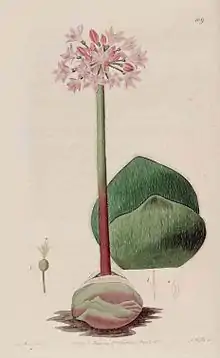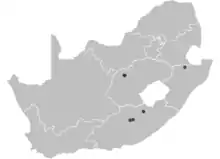Haemanthus carneus
Haemanthus carneus ('carneus': Latin 'flesh-coloured') is a South African bulbous geophyte in the genus Haemanthus. Despite a fairly wide distribution, it has been collected from only a few scattered sites in the Orange Free State, KwaZulu-Natal and the Eastern Cape near Grahamstown and Somerset East, occurring between 300 m and 1200 m above sea level.
| Haemanthus carneus | |
|---|---|
 | |
| Plate 509 from The Botanical Register | |
| Scientific classification | |
| Kingdom: | Plantae |
| Clade: | Tracheophytes |
| Clade: | Angiosperms |
| Clade: | Monocots |
| Order: | Asparagales |
| Family: | Amaryllidaceae |
| Subfamily: | Amaryllidoideae |
| Genus: | Haemanthus |
| Species: | H. carneus |
| Binomial name | |
| Haemanthus carneus | |
 | |
| Distribution over South Africa | |
| Synonyms[1] | |
| |
The bulbs grow in small clumps in the shelter of trees, bushes and rocks. Their tunics are more or less equal with horizontal leaf-scars. Leaves number two or three, usually flat on the ground, appearing with the flowers or following on soon. Peduncles show quite a variation in length from 100–200 mm long. H. carneus was first described in 1821 by the English botanist John Bellenden Ker Gawler (1764-1842), first editor of Edward's Botanical Register.
References
- "The Plant List: A Working List of All Plant Species". Retrieved 18 February 2015.
- The Genus Haemanthus: A Revision - Deidré Snijman (National Botanic Gardens of South Africa 1984) ISBN 0-620-07339-X